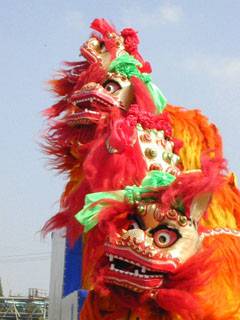 As one of the traditional folk arts in China, lion dancing with a history of over 1,000 years has been and still is a popular recreation for Chinese to celebrate the coming of new year and other big occasions. Also named "Peaceful Melody" in ancient China, lion dancing was fully developed in theTang Dynasty. It has two traditions, the Northern and Southern styles.
As one of the traditional folk arts in China, lion dancing with a history of over 1,000 years has been and still is a popular recreation for Chinese to celebrate the coming of new year and other big occasions. Also named "Peaceful Melody" in ancient China, lion dancing was fully developed in theTang Dynasty. It has two traditions, the Northern and Southern styles.
The Northern style of Chinese lion dancing appeared much earlier. It is said that Emperor Wu in the Beiwei Dynasty (386-534) ordered his captives to dance for recreation. Pleased with their dance, the Emperor Wu named it as "Beiwei Lion" and set the captives free. From then on lion dancing spread widely in the north.
In terms of the Northern style, it is not unusual to have a small lion performed by one person and a larger one performed by two people. Another person standing in front of the lions tries to entice them to jump, spring, leap up, or step on a rolling ball.
There are many different tales about the origin of the Southern style, but none has historical records. One of the tales says it was EmperorQianlongin theQing Dynasty(1644-1911) that made the order to dance in the form of lions.
The Southern style is different with the Northern one in that it is much more gentle. A lot of actions like titillation, shaking, and licking hair showcase the gentleness. The Chinese consider the lion dance to be a vehicle for dispensing all the good blessings of heaven to the whole community. It represents the hopes and aspirations of the Chinese people for all the good things life holds.
